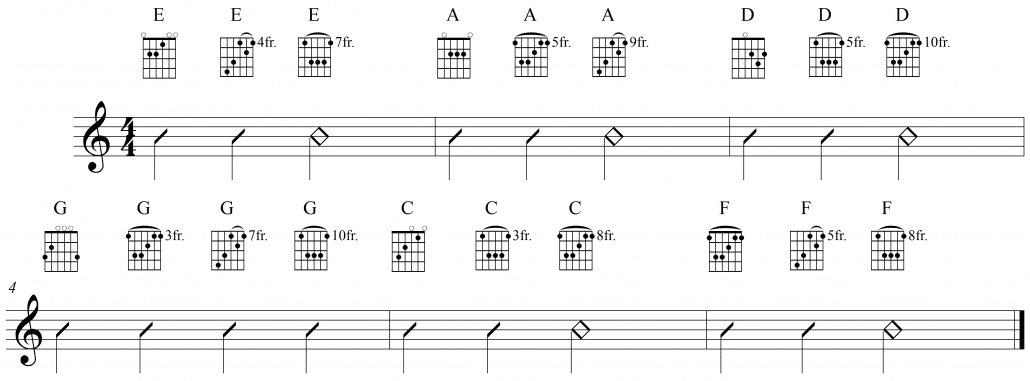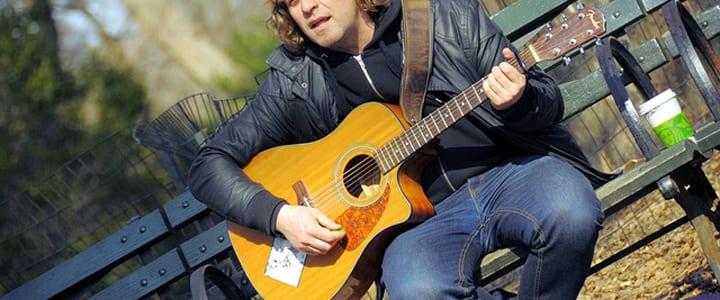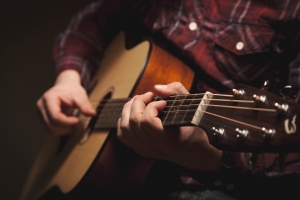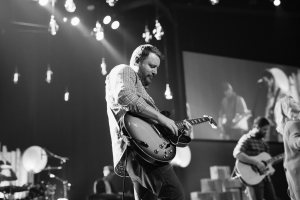 Strumming a chord sounds pretty good, but these rhythm guitar techniques truly bring a song to life! Guitar teacher Jerry W. shares the tricks you’ll need to have up your sleeve…
Strumming a chord sounds pretty good, but these rhythm guitar techniques truly bring a song to life! Guitar teacher Jerry W. shares the tricks you’ll need to have up your sleeve…
Rhythm guitar is both easy to learn and hard to master.
It is relatively easy to learn the open chords and strum along with someone as they sing.
But what if you want to take your playing to the next level? What are some of the essential techniques that will help you become a more complete rhythm guitarist?
Let me suggest seven key skills and rhythm guitar tricks that will help you excel at your craft.
What is Difference Between Lead and Rhythm Guitar?
If you’re wondering why you should bother to learn these rhythm guitar techniques in the first place, just consider the main differences and similarities between lead and rhythm guitar:
- Rhythm guitar drives the music while lead guitar adds melody
- Although rhythm guitar can provide part of the harmony, it doesn’t have to
- Playing lead guitar can be more challenging as you’ll need to move your fingers faster and more intricately
- Rhythm guitar uses mostly chords to drive the music
Although there are clearly stark differences between lead vs. rhythm guitar, there are also many similarities. You can practice both styles of guitar the same way and you’ll play the same exact instrument.
If you’re new to this style of playing, you may want to take some rhythm guitar lessons. This is the best way to get the hang of things. You’ll start with the basics of playing guitar that will serve you well regardless of the type you choose later on.
Take this video, for example, which acquaints you with the fundamental chords you need to know:
What is Rhythm Guitar?
Before we dive into the best rhythm guitar exercises and techniques to help you learn how to play rhythm guitar, it’s important to first understand what it actually is.
A quick way to explain rhythm guitar for beginners is that it is the same instrument as lead guitar but more focused on chords and riffs.
The music produced by a rhythm guitarist isn’t meant to stand out on its own but instead, to form the backbone of the song. It doesn’t focus on melodies and solos but instead on creating a driving beat for the rest of the band to follow.
If you’re curious about how to play rhythm guitar in a band, you may find it helpful to know that rhythm guitarists tend to focus on the following:
- Strumming or fingerpicking chord progressions
- Strumming power chords
- Playing low-end riffs
Best Rhythm Guitar Exercises and Techniques
Master these rhythm guitar techniques and you’ll be well on your way to learning some of the best rhythm guitar songs!
1. Power Chords
Power chords are a great way to add color to your playing and, even better, they are simple to learn. Because of their unique “open” sound they work well with distortion and are very common in many styles of popular music. Below are the two most common movable power chords.

2. Palm Muting
Muting the strings give the guitar a completely different sound. It muffles the tone and shortens the duration of the pitch. To mute the guitar simply place the side of your picking hand lightly against the strings very close to the bridge. The trick is to use the right amount of pressure so the notes sound muffled but not completely stopped. This technique works great when combined with distortion and power chords. To take this technique one step further, try playing selected notes open to give it a strong accent. In the following example the ‘+’ is over the notes to mute and the ‘o’ is over the notes to play open. Try this pattern with any power chord.

3. Fret Hand Muting
A great way to create rhythmic variety in your strumming is to learn to use fret hand muting. To mute the strings with your fret hand all you need to do is lighten the pressure from the frets so that the strings are dampened. This is different from palm muting in that you do not want the pitch to sound at all.
The effect should be more of a “thunk” sound.
When you intermix open strums and dampened strums you can create very interesting rhythmic patterns. This method works easiest with barre chords. A similar effect can be accomplished by laying your pinky over the strings when doing open chords. In this example the x note heads represent the dampened strums.

4. Fingerpicking
Learning how to fingerpick on your guitar will open up a whole new world of accompaniment patterns. Fingerpicking has a much lighter feel and allows you to create complex moving lines.
5. Playing in the Higher Frets
Many rhythm guitarists never learn to use the full range of the guitar. They play almost exclusively in the the first 5-7 frets. To be a more complete guitarist learn to use the higher frets. There are two ways to play in the higher frets: 1) use a capo, 2) learn the movable barre chords. Using a capo is both a simple and effective way to quickly add a higher range to your playing. Learning the movable barre chords will take a little more work but will pay off in the end. Try this exercise to memorize some of the higher chords.

6. Hammer Ons and Pull Offs
Hammer ons and pull offs are a little harder to master than some of the other techniques but they are well worth the effort. They are especially effective when combined with fingerpicking, but they also work with many strumming patterns. To hammer on, use your fretting finger and hammer it down on the fret to sound the pitch. For a pull off, you sound the pitch by pulling your finger off of the string in a manner that plucks the string. Here is a simple strumming pattern that includes hammer ons.

7. Chord Inversions and Slash Chords
My final essential technique for rhythm guitar is to learn chord inversions. This is a very complex topic and requires that you know the names of the notes on each of the lower strings. The goal is to be able to play the bass note that is requested when you see a slash chord, such as a G/B chord. This techniques is best used when there is no bass playing. It allows you to capture the sound the composer intended even though the bass is absent. Essentially you play the chord on the left side of the slash but make sure the note on the right of the slash is the lowest sounding note. Notice how this works in the following example.

Why You Should Learn Rhythm Guitar
Rhythm guitar is one of the most challenging skills to develop as a guitar player – yet it’s also one of the most valuable aspects of guitar playing. Mastering the basics can be tough, but hopefully, now that you have an idea of some fundamental rhythm guitar tricks and techniques, you’re on your way to becoming a better player.
Learning rhythm guitar has multiple benefits:
- Improves your timing skills
- Is easier to start with
- Lets you choose your own path – you can always go on to learn lead guitar later on!
Learn these seven rhythm guitar techniques and you will be well on your way to becoming a complete guitar player.
Looking for more guitar tips and tricks? Lessons with a private guitar teacher are the best way to learn to play the guitar better, faster! Search for a guitar teacher now!
 Jerry W. teaches classical guitar, composition, trombone and trumpet in Grosse Pointe, MI. He received his Bachelor of Music in Theory and Composition from Cornerstone University and went on to receive both his Masters and PhD in Music Composition from Michigan State University. Jerry has been making music and teaching students for over thirty years. Learn more about Jerry W. here!
Jerry W. teaches classical guitar, composition, trombone and trumpet in Grosse Pointe, MI. He received his Bachelor of Music in Theory and Composition from Cornerstone University and went on to receive both his Masters and PhD in Music Composition from Michigan State University. Jerry has been making music and teaching students for over thirty years. Learn more about Jerry W. here!
Photo by faungg’s photo
Megan L.





